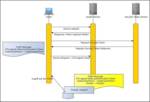- WP1 Stocktaking
- WP2 Validation system
- WP3 ICT Development
- WP4 Piloting
- WP5 Certification
- WP6 Training
- WP7 Evaluation
- WP8 Product Finalisation
- WP9 Dissemination
- WP10 Valorisation
 This project (519132-LLP-1-2011-1-DE-KA3-KA3MP) has been funded with support from the European Commission. This communication reflects the views only of the author, and the Commission cannot be held responsible for any use which may be made of the information contained therein.
This project (519132-LLP-1-2011-1-DE-KA3-KA3MP) has been funded with support from the European Commission. This communication reflects the views only of the author, and the Commission cannot be held responsible for any use which may be made of the information contained therein.
Software report
WP3: ICT Development
State of Play Year 1:
the LEVEL5 software was further developed. Through the planned introduction of the ECVET Specification 2014, the need arose to combine the LEVEL5 software, or the underlying pedagogical approach with the ECVET specifications. To satisfy these and other new requirements, it was decided to re-develop the software from scratch. Against the back-ground to achieve a loose coupling between the user interface and application logic the new software has been designed as a web service in the framework of the VITA project. The software documents all five procedural steps, i.e. data of each of the five procedural steps can directly be inserted into the software. It has a multi-user function which allows data shar-ing, cloning and customizing, e.g. reference systems and their level descriptions on the three dimensions can be re-used and/or further developed by other users. Also the scaling is com-pletely flexible: LEVEL5 requires five competence levels, whereas the EQF requires eight. Also an individual number of levels (up to 15) is possible. Certificates (or learning tickets as we call them) can be layouted individually.
The software has been created on state-of-the-art technology facilitating a multi-user approach which facilitates a learner management, connection to external databases and also mobile applications.
In connection with WP01 a desk research on available IT based validation systems was carried out to explore existing technical specifications for the interfaces to EQF systems. There is a number of projects and initiatives working on the assessment of personal and social competences in the different educational contexts and for different target groups. There are also singular projects applying stand-alone or web-based software. However, there is hardly any evidence for a systematic implementation of IT-based validation of competences that established IT-specifications to enable the exchange of data from one system to the EUROPASS or EQF-based systems (e.g. to facilitate data exchange from participant databases (universities, institutes) to EUROPASS etc.) . By the end of 2012 only singular projects could be identified that worked on this topic. There were some hints that CEDEFOP would have more internal information on this and stakeholders from the Euroguidance network also promised support.
The IT experts in VITA concluded that there are yet hardly any specifications on EQF available except some research projects like eCOTOOL that proposed own solutions. However the flexible architecture of the LEVEL5 software technology will be able to respond to new parameters in future specifications as well.
The second objective, the creation of a VITA e-portfolio was realised on the basis of an desk research on available e-Portfolio systems. (deliverable: decision matrix on available e-Portfolios). Grounded on these findings the project team decided to introduce a Mahara e-portfolio, to customise it for VITA in terms of functionalities, CI and interfaces (EUROPASS).The software has been created on state-of-the-art technology facilitating a multi-user approach which facilitates a learner management, connection to external databases and also mobile applications.



